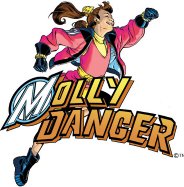We begin this week with a special treat. Thor stalwart Devon Sanders was an enthusiastic Kickstarter contributor to the Action Lab Studios launch of Molly Danger, and before we get to his review of the first installment, please enjoy his exclusive interview with Molly Danger writer/artist Jamal Igle.
Artist/writer Jamal Igle is legit one of the nicest people I’ve ever met. Add to that that, he’s an incredible artist who can always be relied to not only deliver beautiful work but deliver it on time and he’s one of comics’ best. Having worked on well known characters such as Supergirl, G.I. Joe, Wolverine and more, Jamal’s struck out on his own with the new release form Action Lab Studios, Molly Danger…
Devon Sanders: What was the first comic you ever read that made you think, “Oh, my God! COMICS!!!”
Jamal Igle: Well, I started reading comics around 5 or 6 years old, so it just seemed sort on natural for me to be around them. It wasn’t until I was about 14 years old when I really saw what comics could be. I was just beginning to attend the High School of Art and Design in New York when The Dark Knight Returns, Batman: The Killing Joke, Watchmen, John Byrne on The Fantastic Four,then Superman started coming out on the stands. That was the moment when I realized “WOW! This is what comics can do!”. Scott McCloud’s Zot and the Destroy one-shot, The Rocketeer, Love and Rockets, Nexus, Badger were the books that became part of my regular rotation.
DS: Sounds like we came to comics pretty much right around the same time. So, what artists inspired you early on and still inspire you to this day?
JI: Well, it all started for me with John Byrne and Arthur Adams, but every budding comic artist of my age started out copying those guys. As I got older I became enamored with Dave Stevens, Steve Rude, Brian Bolland, Jerry Ordway, Kevin Maguire, Jose Luis Garcia Lopez, Stuart Immomen and Ty Templeton. These days there are so many great talents working in comics, it’s difficult not to be inspired.
DS: Were your parents supportive of your burgeoning love of comics?
JI: To a point, I don’t think my mom completely understood what I was attempting to do but she was supportive.
DS: If you could sit down and have a 24 hour master class with any comics pro, past or present, who would it be?
JI: Probably, Alex Raymond, legendary artist of the Flash Gordon comic strip.
DS: A lot of folks want to become comics professionals and for one reason or another, don’t, can’t or don’t want it as much as the next person; what do you think set you apart from the rest?
JI: Comics are an obsession for me; while it may not be the healthiest obsession to have sometimes, that’s the truth. I believe in comics as a medium, an art form, and as a vehicle of expression. I don’t know it it’s what set me apart but it’s what drives me. I’ve worked in other media likew animation and film, but for me, the power of comics is the melding of art and prose in a narrative form.
I could have walked away from the industry a few times over the years, but it means too much to me to not be a part of it.
DS: You may be best known for your work on Supergirl; you made a conscious decision to eliminate a 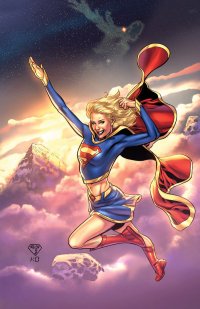 lot of the sexualization others had brought to the character. Were you worried about the fan reaction in your having done so?
lot of the sexualization others had brought to the character. Were you worried about the fan reaction in your having done so?
JI: No, because I don’t make these types of decisions for anyone else’s edification but my own. It’s selfish, I guess, but it’s true. I wanted to impose my vision of what Supergirl could and should be on the character and I did it in increments. The fact that (Supergirl writer) Sterling Gates was thinking along the same way certainly cemented it for me as well. I don’t think I was prepared for the positive reaction we got from feminists blogs, NPR and the like. Neither was DC, frankly.
They started getting pressured by the same groups who were praising our rehab of Supergirl to make similar changes to other DCU characters. I actually got a call from the Public Relations department saying they were going to turn down further interview requests from newspapers. We did get a little backlash from a subset of fans who felt that I was imposing a double standard against Supergirl by toning down the sexiness. I suggested that they buy a copy of Hustler for their jollies instead of a comic book about a teenager.
DS: Was there anything left unsaid in that run you wish you could follow up on?
JI: No, there were things that I would have liked to explore more, Like the Lana/Linda Lang relationship dynamic and Linda (Supergirl) becoming an intern at the Daily Planet. I’m proud of our run.
DS: After six-years of exclusivity with DC Comics, you announced you were going solo; how big of a leap of faith was it for you to put yourself back out there again?
JI: I didn’t really see it that way. I saw it more as something I needed to do. I had worked for DC off and on for the majority of my career, including my exclusive years. I had a lot of good times and bad times, but I also lost out on a ton of opportunities being exclusive. I enjoy the freedom of being able to do different types of projects more than being exclusive for a single company. I never would have been able to complete Molly Danger, had I, for example went to Marvel and signed an exclusive with them.
DS: Glad you brought up Molly Danger, I backed it on Kickstarter and have been really looking forward to this; does ownership motivate you any differently within the creative process?
JI: It certainly made every creative decision that much more personal and immediate. It also forced me to relearn a lot of skills that I had allowed to lapse because I was always so busy with other projects. I’ve worked harder on Molly Danger than I have on any other project.
DS: Molly Danger has a great and racially diverse cast; one of my favorite artists ever, Mike Wieringo, also did this and it was always great to see. Was this important for you to do as well?
JI: Of course it was; more importantly, I wanted to reflect a sense of natural diversity in Molly’s world. It will become more and more diverse as the books go along.
DS: Molly Danger, to my knowledge, is your first solo writing gig. Is more writing in future?
JI: I’ve already started developing some other projects; some of which are set to begin next year for a 2015-2016 release.
DS: Where do you see yourself and Molly Danger in the very near future?
JI: Everywhere… this arc is just the beginning for Molly Danger!
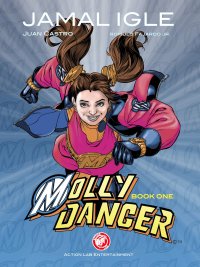 MOLLY DANGER HC BOOK 1 (Action Lab Studios, $14.99)
MOLLY DANGER HC BOOK 1 (Action Lab Studios, $14.99)
By Devon Sanders (@devonsanders)
It’s rare that you actually have a hand in making the books you review. Thanks to things like Kickstarter; it’s a thing that’s happened.
About a year ago, I’d helped fund, through Kickstarter, Jamal Igle’s Molly Danger HC Book 1 for one simple reason; I wanted to read it.
I wanted to see what one of comics’ best artists would do left to his own imagination. Molly Danger doesn’t disappoint and leaves you wanting more but in this case, I don’t know if that was the intent.
20 years ago, a rocket fell from the sky, killing all aboard save for one lone girl. On Earth, this girl would become Molly Danger, the world’s most powerful 10 year old. In that time, Molly has become the protector of Coopersville and due to her alien status, forced into isolation from humanity due to her association with D.A.R.T., an organization devoted to monitoring her every action while helping her keep Coopersville safe. Molly craves a child’s life and when a fighter pilot with a kid who also happens to be her biggest fan sees this… everything changes.
Jamal Igle’s art is as stellar as ever. People come in all shapes and sizes and he keeps the eye flowing effortlessly from panel to panel with dialogue that easily props up the panel’s happenings. My only gripe with Molly Danger is that there simply isn’t enough of her in the first book to gauge who she is. We’re told she’s incredibly dangerous but I never quite got a sense of why other than she’s an “alien”. Igle writes her as an ok kid with hopes and dreams but never quite says why anyone should perceive her as anything other than a well-intentioned kid.
Molly Danger Book 1 is what I paid for; a fun, energetic book with tons of potential and leaves me looking forward to its future.
Rating: 




Out of a Possible 5 Stars
3 Guns #1 (BOOM! Studios, $3.99) 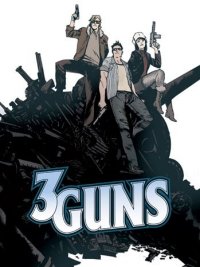
By Graig Kent
Digging through the archive.org Wayback Machine I managed to find my review of the first issue of 2 Guns from an old review site 6 years defunct, where I called it “cinematic popcorn fun” that “twists and turns like a mountainside highway” (it’s very surreal, paraphrasing one’s self). I genuinely liked that book and the appeal of the experience had left a lasting impression, so much so that back at the end of 2007, I listed it as one of my favorite books of the year. I’d long thought that it would make a pretty great sub-blockbuster action film, and I was quite pleased to see it on this year’s slate of summer releases. I haven’t seen the film yet, so I can’t comment on how the movie stacks up against the source, , but then I haven’t revisited the comic since the mini-series ended a half-decade ago, so I can’t honestly say if it even still holds up.
What I have read, however, is the first issue of creator Steven Grant’s follow-up, unsurprisingly released to coincide with that of the film, and you know, it’s pretty great too. It’s doubtful that 3 Guns will be making my best-of list for the year, but it delivers on everything that I remember about the original: punchy dialogue, likable characters, violence, and, yep, more than it’s fair share of twists. My recollection of the original is cloudy at best, but the characters, Bobby “Bobby Beans” Trench and Marcus Stigman, are instantly familiar when they appear (it’s like returning to John McClane in Die Hard 2, or Riggs and Murtaugh in Lethal Weapon 2), as is their amusingly heated dynamic.
As the title would suggest, there’s a third person involved in the double-crossing, undercover criminal exploits of the ex-DEA and NCIS agents, but at this stage it’s a complete guessing game about how much each knows about the other’s motivations and objectives within a planned arms deal. As with the first one, there’s a level of convolution that you’re either going to be greatly amused with or otherwise put off by, but it works for me. Grant’s storytelling is thoroughly clean, tight, briskly paced with plenty of forward momentum. Like 2 Guns, it’s very cinematic in its structure, but keeps in consideration it’s 5-chapter breakdown. Even if it began life as a screenplay (as the original did), Grant is a journeyman comics scribe, so he knows how to adapt to medium effortlessly.
Grant is paired with artist Emilio Laiso, who brings a clean, naturalistic style with him, with a hint of cartoonishness to allow for a more heightened expressiveness out of his figures and faces. He has a Joe Phillips or Jason Pearson quality to his ink work and his characters physical appearances, which, were he not Italian (maybe even still), would suggest an influence of the old Gaijin Studios crew. Laiso guides the story through its paces with a mind to servicing the story rather than showcasing the art, dressing the characters and establishing sets and scenes with a perfect level of detail and consistency, enough to capture the environment but not overwhelm the story. He also largely structures his panels to cross the whole page to get a widescreen effect, thus maintaining that cinematic quality Grant’s script strives for.
I like the idea of a comic book version of an ’80’s-style buddy-action movie franchise, and Steven Grant seems quite ready to deliver us such. Is there going to be a 1 Gun prequel?
Rating: 




Out of a Possible 5 Stars
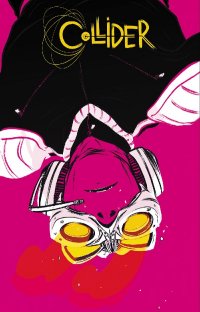 Collider #1 (Vertigo, $2.99)
Collider #1 (Vertigo, $2.99)by D.S. Randlett (@dsrandlett)
Either because I’m attracted to reading such things, or because such ideas actually are everywhere these days, I can’t seem to get away from parallel universes. Most recently there was Guillermo Del Toro’s Pacific Rim, which featured giant beasts sent across dimensions to invade this one by transplanar invaders. But more generally, I seem to be hearing from physicists like Brian Greene about how it’s mathematically probable that there are an infinite number of universes dotting existence like holes in swiss cheese. For most, this idea conjures images of versions of our own lives where we made different decisions. You might think about how there’s a world where you’re rich, or one where you’ve married your high school sweetheart. Maybe I think about other possible worlds too much: what about worlds where the arthropod remained the dominant life form on Earth? What about the infinitude of universes where the physics are completely different, and thus are populated by entirely different sensations of falling and reconfigured periodic tables?
Simon Oliver and Robbi Rodriguez’s Collider looks to run with that last concept. Instead of an entirely new universe being introduced to us, they opt for a changing of our own. The rules, a character says in a flashback during the first pages, are changing. Flash forward years later, and random pockets of anti-gravity form around high schools. During such incidents, emergency calls go out to the Federal Physics Bureau, and agency that repairs the spontaneous damage that existence seems to be doing to itself. When the story picks up, the Bureau has this stuff down, but once again the patterns are shifting, and they might not be ready for what’s coming.
Being the first issue of the series, this month’s Collider is more concerned with introducing its main characters and concepts. And being something of a mystery series, Oliver’s script is more interested in letting you know that it’s holding a hand rather than playing it. He’s more than willing to drop a few hints our way, as in a scene with a rather shady customer, but right now the series’ main thrust is questions. The one that the writing is pointing to most loudly is: “Is there intention behind what’s happening with the laws of physics?” So, probably. The characters are all pretty familiar types, falling into a sort of Ghostbusters mold, with two key characters existing as condensations of those different personality types. It plays okay, but feels a little too familiar.
The concepts really come through in the art, which is where Collider really shines. Robbi Rodriguez gets across the world’s physical aberrations with a cartoonish style where limbs and perspective shift with equal intensity. Even when they’re not at the epicenter of some event, characters look like they’re being twisted, or going down a drain. Rodriguez captures a world out of balance, a place where everything can be ripped apart at any moment. The art is a fine example of the balance between tension and humor, and it really elevates the book.
I think that once the story kicks into gear and the concept goes to some more interesting places, Collider is going to be worth your time. The first issue holds a lot of promise, but not really any satisfaction in and of itself despite the talent and intelligence on display. Give it another few issues, and Collider might be something special.
Rating: 




Out of a Possible 5 Stars
Batman Incorporated #13 (DC, $2.99)

By Graig Kent
7 years ago when Grant Morrison began his run on Batman, we had no idea where it was going, or what the scope of his story would hold. In that first issue he introduced Damian, Batman’s son with Talia, a vile, murderous little creature so unlikable he caused me to quit reading the book a few issues later. As things played out, Bruce Wayne took this damaged little boy into his care, as he is wont to do, and just as they were starting to find common ground, Bruce was up and killed in “R.I.P.” (well, Final Crisis actually). Morrison moved from the main Batman book to a new title, Batman and Robin, which allowed him the opportunity to reverse the emotional disposition of the Batman and Robin dynamic, by putting a sunnier Dick Grayson in the cape and cowl, and having Damian’s sarcasm and scowl as his sidekick. Morrison eventually brought Bruce Wayne back, but not without first providing him with Bat-themed legacy as he time jumped throughout history. This led to the final step in his Bat-plan, Batman Incorporated, a way of putting the character’s influence into a global context, providing Batman a worldwide army he could call upon should the situation arise (which of course it did).
Of course Morrison’s final act was interrupted by DC Comics line-wide reboot, which caused a full year break in the title It also led to the status quo Bruce Wayne being roughly a decade younger than he was before, and various members of Batman’s entourage either being drastically changed (Barbara Gordon) or non-existent (Stephanie Brown). It seems apparent that the break put a crimp in Morrison’s plan for the series to explore the international waters of the DCU and put a Batman in every country. Almost instantly upon Batman Incorporated‘s New 52 return it seemed apparent that Morrison’s ideas no longer held the same weight in the new universe. A younger Batman seemed like he should be less desperate to brand himself internationally, less inclined to accept his limitations, less invested in things not-of-Gotham. Rationalizing Batman’s four sidekicks has become one of the main sticking point of the rebooted-but-not Batman line, and beyond a throwaway dialogue balloon, Morrison left expounding upon that (particularly having a 10-year-old son) to other writers.
Each step of Morrison’s journey with Batman was filled with the intent of exploring the durability of character in as diverse a context as possible. There was romance in Bruce and Jezebel Jet’s coupling, leading to the soap operatic betrayal orchestrated by Simon Hurt, there was the 60’s acid trip with Zur En Arrh and Bat-Mite, and the sci-fi aspects as he time traveled in The Return Of Bruce Wayne. The globe-trotting adventurer was explored early in Batman Inc, and throughout it all, an exceptionally keen eye on family, not just the father-son moments with Damian leading to his death and the mourning that followed, but his adopted family, Alfred, Dick, and Tim, the Wayne legacy and Bat-themed connections, and the expansive Batman Family, that continued to grow through incorporation.
The new additions to the Batman Family introduced pre-reboot took a notable back seat upon the book’s return, however, and if anything Batman Incorporated simply became “Morrison’s Batman book”, a place where he could wrap up his multi-year epic opera, looping back to the opening “Batman and Son” chapter, while aLSo bringing to a conclusion the Leviathan arc he had originally set up for this series. This final issue finds Batman and Talia face-to-face while the league of Batmen face off against all that Talia’s put in their way. It’s a rather frenzied 24 pages that seems to hit upon all the necessary touchstones to close out Morrison’s run in a grandiose manner, but it also feels like an abrupt and slightly defeated effort, like the writer didn’t get to do what he wanted, as he wanted, and the compromise to do so wasn’t worth the continued effort. The Kathy Kane re-introduction last issue, and her role this issue don’t seem to have the same meaning in a New 52 context, nor has Jason Todd’s erratic role in the festivities, nor a great many other aspects of Batman’s storied past Morrison uses that should be wiped away (or at least made highly implausible) with a scaling back of age. It’s not that Morrison goes out with a whimper, there’s a concerted effort here to wrap his journey up in as satisfying a manner possible, but that emboldened “THE NEW 52!” sublogo on the cover is the primary obstacle in achieving it.
Morrison doesn’t so much as close out his run as leaves his toys in the public sandbox for others to play with or break or bury as they see fit. He leaves with lasting impact, even outside of Damian, his biggest contribution to the mythos, and there’s a lot of open-endedness here. The introduction and re-introduction of so many characters and concepts into the Bat-Family leaves lots of opportunity for other writers and artists to explore the diversity of both the character and the symbol, while sparing Morrison the burden of finality. I don’t believe that Morrison has said all that he has to say with the character, but he’s reached the limit of what he can do in the current environment.
As the latest (/final) issue of Batman Incorporated, it’s an exciting, engaging read, if frustratingly compressed. A mere 24 pages can’t seem to touch on all the points it could possibly touch upon to create a satisfying ending for all the Incorporated members, and to resolve the effects of the events of the series upon the characters’ lives. But like any good movie, television show, or book where you’re engaged with the characters and invested in the story, an ending only leaves you wanting more. Chris Burnham’s rather indie sensibilities have always been an odd fit with this mainstream title, although it’s those same tendencies that fit so well with Morrison as a writer. Burnham gets plenty to work with in this one, and delivers an outre performance, giving Bruce Wayne one of his most grizzled looks since The Dark Knight Returns, and remaining playful with panel construction (if anything he didn’t push it far enough). Burnham’s style is alternately awkward and impressive, with stiffly posed figures or contorted and/or cartoonish facial expressions juxtaposed against an exceptional eye for detail and consistency in carrying that detail forward. Batman Incorporated has definitely benefited from having a primary artist across its run, and even if Burnham doesn’t quite live up to the Andy Kuberts or Frank Quitelys or Yanick Paquettes, he could keep up with Morrison and be the consistency when everything else was erratic.
I’m quite certain that this final issue will read differently picking it up a month(ish) after the last one, than it will having reread Batman Inc from the start of the New 52 run, than it will rereading the full series run from the beginning, than it will reading back to Morrison’s first Batman and Son story. When the time allows, it will be interesting to see how its context changes. Equally it will be interesting to see Morrison’s overall impact on the Bat-lore going forward.
Rating: 




Out of a Possible 5 Stars
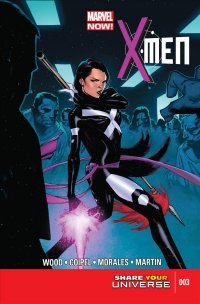 X-Men #3 (Marvel, $3.99)
X-Men #3 (Marvel, $3.99)
Fearless Defenders #7 (Marvel, $2.99)
Captain Marvel #14 (Marvel, $2.99)
Journey Into Mystery #654 (Marvel, $2.99)
By Jeb D.
Gender distribution is a hot topic among Big 2 watchers these days, and this week brings key issues of a few of Marvel’s more significant female-focused titles. All four pass the Bechdel Test: what else do they have to offer?
Much publicity ink last year went to the “relaunched” X-Men title (the lack of a modifier distinguishing it from, say, Uncanny X-Men or Astonishing X-Men or…) from Brian Wood and Olivier Coipel, due largely to its promise of an all-female cast of principal characters. And while Wood has enthusiastically rejected the notion that this is a gimmick, he and Coipel have wisely made this first 3-issue arc into a sort of curtain-raiser for the series that allows them to get their feet under them before having to address the question of just how effective a (principally) male team of comic creators can be when they’ve put their focus on a (principally) X-chromosome team. The brisk pacing covers familiar territory for the franchise (the pressures of motherhood, questions of identity and responsibility in the umpteenth “innocent- victim-possessed-by-deadly-foe” encounter), but also finds room for an action-movie style train chase. The core group (including Storm, Rogue, and Jubilee) seem to have been chosen for their strong, consistent characterization in recent years, Wood easing us into his series with an assortment of familiar voices. He partners well with Coipel (well, frankly, who doesn’t?) and Laura Martin offers her usual fine coloring job, though I’m sorry that Coipel couldn’t ink the entire issue himself, as there’s a slickness to the pages handled by Mark Morales that doesn’t blend as well. The result is a comic that has some of the perceptive character work of Wood’s Ultimate X-Men run, but with sharper, more stylish action. If this keeps up, the potential is there for this to be among the best X-Men series so far.
Fearless Defenders has always felt rather a schizoid comic: from Mark Brooks’ cleverly gimmicky covers that peek 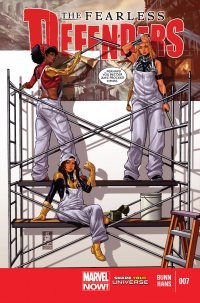 around the fourth wall, to the mingling of gee-whiz goofiness and snarky one-upsmanship with what are supposed to be apocalyptic conflicts, writer Cullen Bunn occasionally mistakes inconsistency for unpredictability. He also never completely gets the mismatched partners thing to gel: he’s clearly much more comfortable with, and interested in, Valkyrie than in her purported compatriot Misty Knight, and apart from the cute bantering that constitutes the recap page, neither heroine seems to particularly complement the other. The first six-issue arc relegated Bunn’s newly-introduced character, the smitten-by-Val archaeologist Annabelle Riggs, to little more than a plot device to heap guilt on Valkyrie, for killing her would-be inamorata in a fit of berserker rage. Will Sliney’s art was big and bold, and (apart from the odd gratuitous butt-shot) mostly avoided fan service, though he was much better with the splash panel than sequentials. The series teetered on the edge of strong/mild recommendation, but with plenty of potential.
around the fourth wall, to the mingling of gee-whiz goofiness and snarky one-upsmanship with what are supposed to be apocalyptic conflicts, writer Cullen Bunn occasionally mistakes inconsistency for unpredictability. He also never completely gets the mismatched partners thing to gel: he’s clearly much more comfortable with, and interested in, Valkyrie than in her purported compatriot Misty Knight, and apart from the cute bantering that constitutes the recap page, neither heroine seems to particularly complement the other. The first six-issue arc relegated Bunn’s newly-introduced character, the smitten-by-Val archaeologist Annabelle Riggs, to little more than a plot device to heap guilt on Valkyrie, for killing her would-be inamorata in a fit of berserker rage. Will Sliney’s art was big and bold, and (apart from the odd gratuitous butt-shot) mostly avoided fan service, though he was much better with the splash panel than sequentials. The series teetered on the edge of strong/mild recommendation, but with plenty of potential.
As Fearless Defenders kicks off its second story arc, it’s tempting to gloss over any flaws in the script for the rare chance to savor stunning interior art from Stephanie Hans. Her covers for Journey Into Mystery were right up there with what we expect from books like Fables, but when she finally got the chance to offer her glorious painted interiors on Kieron Gillen’s final issue of the series, she gave us the best single-issue superhero comic artwork of 2012. And while I seriously doubt we can expect her to become the regular artist on this book (or any monthly) she goes a long way to adding some gravitas to Bullen’s scattershot script.
You see, since Annabelle died at the hands of a Valkyrie, she’s not “dead dead”—she’s not even “comic book dead”—she’s kicking in Valhalla, bored and alternately annoyed and intimidated by the rowdy Vikings, warriors, and wenches that populate the place. While it’s an amusing conceit, it does tend to undermine issue #6’s big dramatic finish. Nonetheless, Val seeks help from Dr. Strange’s sorcerous ex, Clea, to get Annabelle back. This naturally comes at a cost, and what seems to loom ahead might be an even trickier balancing act, tone-wise: two characters forced to carry on an intimate relationship within the same body calls for the high-minded absurdity of a Grant Morrison, or the clear-eyed empathy of a Neal Gaiman; I have my doubts whether tossing in a bit of Misty Knight sass, and a few doofy male guest stars, will be enough to keep the conceit from getting slightly creepy in future issues. Still, Hans gives the proceedings the appropriate mythic feel: she’d be the perfect choice for a new Dr. Strange series, evoking the classicism and storytelling inventiveness of Frank Brunner’s beloved work on the Doc, and she’s the reason this is the best issue of Fearless Defenders so far.
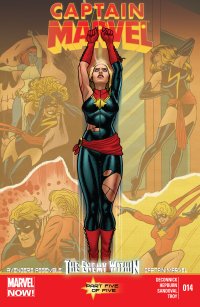 Of course, we might also take a moment here to consider a female-centric book that is—what a concept!—written by a female. This issue of Captain Marvel wraps up “The Enemy Within,” writer Kelly Sue DeConnick’s five-issue crossover with her Avengers Assemble title. From the first, DeConnick has had trouble straddling the fun-and-games action of Assemble with the more “grounded” character work of Captain Marvel (and no pun intended there: much of her CM run has used flight as a metaphor for accomplishment and self-worth, with remaining earthbound a difficult fate for its characters to accept). She’s handled the overarching story well enough, as the exiled Kree warrior Yon-Rogg wreaks devastation on the Earth, and Carol’s Assembled teammates continue to fall short in their attempts to oppose him. In the end, rather like Fearless Defenders, there’s a sense that everything that happens has been set up arbitrarily to get Carol to the point of crisis regarding the brain lesion that threatens to destroy her memories, and personality, if she takes to the air. It’s not much of a spoiler to say that she’s forced to make the tough choice, and the end of the book (as well as Joe Quinones’ “This-was-your-life” cover) suggests that a very different Carol Danvers will emerge; while I have confidence that DeConnick’s love of the character will produce good results, I will miss Carol’s current incarnation if the change is as significant as seems likely.
Of course, we might also take a moment here to consider a female-centric book that is—what a concept!—written by a female. This issue of Captain Marvel wraps up “The Enemy Within,” writer Kelly Sue DeConnick’s five-issue crossover with her Avengers Assemble title. From the first, DeConnick has had trouble straddling the fun-and-games action of Assemble with the more “grounded” character work of Captain Marvel (and no pun intended there: much of her CM run has used flight as a metaphor for accomplishment and self-worth, with remaining earthbound a difficult fate for its characters to accept). She’s handled the overarching story well enough, as the exiled Kree warrior Yon-Rogg wreaks devastation on the Earth, and Carol’s Assembled teammates continue to fall short in their attempts to oppose him. In the end, rather like Fearless Defenders, there’s a sense that everything that happens has been set up arbitrarily to get Carol to the point of crisis regarding the brain lesion that threatens to destroy her memories, and personality, if she takes to the air. It’s not much of a spoiler to say that she’s forced to make the tough choice, and the end of the book (as well as Joe Quinones’ “This-was-your-life” cover) suggests that a very different Carol Danvers will emerge; while I have confidence that DeConnick’s love of the character will produce good results, I will miss Carol’s current incarnation if the change is as significant as seems likely.
Captain Marvel continues to be plagued with inconsistent artwork, and this issue’s division of labor between Scott Hepburn and Gerardo Sandoval, with color from Andy Troy, suffers from a distracting back-and-forth between the two; I’d also suggest that while I applaud the anti-cheesecake mandate that this series has, marking Carol’s big hero moment by giving her a cartoony Gollum-like mad-face just feels weird. I don’t want to dismiss this crossover out of hand—among other things, its breathless five-issue run didn’t outstay its welcome—but it never quite hit the heights that DeConnick’s two series have managed on their own.
As a sort of footnote, there’s less to say about last week’s Journey Into Mystery, as it’s only the buildup to the story’s 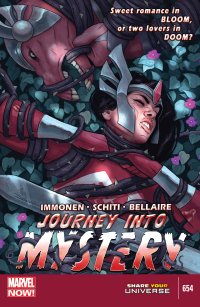 climax, save to lament that this is the penultimate issue of Kathryn Immonen and Valerio Schichti’s run on the title. Succeeding Kieron Gillen’s tumblr-faved epic of mystery, identity, fantasy, and mischief was no easy undertaking, but Immonen’s portrayal of Lady Sif made her among the more interestingly believable—more “human”—protagonists in Marvel’s current line, and this final tale of the ins and outs of love and loss and ‘splode with Beta Ray Bill has been a rousing yarn, with all the Kirby-like grandeur you could ask for among the quieter emotional moments. And while some of the books cited above show incremental progress in nudging the Big 2’s glass ceiling, their commercial success would seem due in some degree to the vast swarm of familiar guest-star characters; the fact that a strong comic with a solo female protagonist, written by one of today’s most interesting superhero writers (who just happens to be a woman), can’t seem to hit the necessary numbers, is a depressing fact that I’ll likely be revisiting when the concluding issue #655 arrives later this month.
climax, save to lament that this is the penultimate issue of Kathryn Immonen and Valerio Schichti’s run on the title. Succeeding Kieron Gillen’s tumblr-faved epic of mystery, identity, fantasy, and mischief was no easy undertaking, but Immonen’s portrayal of Lady Sif made her among the more interestingly believable—more “human”—protagonists in Marvel’s current line, and this final tale of the ins and outs of love and loss and ‘splode with Beta Ray Bill has been a rousing yarn, with all the Kirby-like grandeur you could ask for among the quieter emotional moments. And while some of the books cited above show incremental progress in nudging the Big 2’s glass ceiling, their commercial success would seem due in some degree to the vast swarm of familiar guest-star characters; the fact that a strong comic with a solo female protagonist, written by one of today’s most interesting superhero writers (who just happens to be a woman), can’t seem to hit the necessary numbers, is a depressing fact that I’ll likely be revisiting when the concluding issue #655 arrives later this month.
X-Men #3: Rating: 




Out of a Possible 5 Stars
Fearless Defenders #3: Rating:





Out of a Possible 5 Stars
Captain Marvel #14: Rating:





Out of a Possible 5 Stars
Journey Into Mystery #654: Rating:





Out of a Possible 5 Stars
